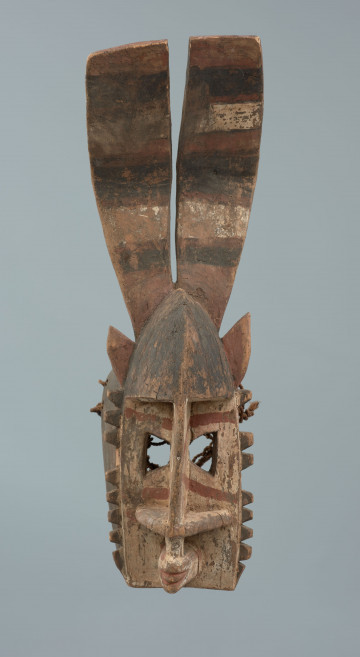
Gomintogo mask
między 1951 — 2000
National Museum in Szczecin
Part of the collection: Collection of Dogonian art
The complete mask of a young girl in the Dogo-so language is called będę, bęzę, and in the Sigi-so language awa pini, meaning young mask. It is made of plant fibres. It consists of a balaclava decorated with kauri shells worn on the head, a breastplate (in the form of a bra) with cups made of baobab fruit, also decorated with kauri shells and multi-coloured glass beads, knitted cotton trousers dyed with indigo, three skirts (black, red and yellow) and bracelets worn on the shoulders and wrists. The dancer holds a stick in his hand, which he swings to the rhythm. Będę dances together with other masks during the Dama funeral festival. With the yona and bambara kaze masks, it guards sa trees from women and children during harvest time.The mask depicts a young Andumbulu girl named Yabêzê being devoured by a lion. Andumbulu are mythical creatures of low stature that live in the bush. A man from her family killed the lion; its shoulder (bone) was extracted and a buguturu altar was built on it. A piece of dannu wood decorated with bloodstained fibres from the girl's loincloth, which she was wearing at the time of her death, was stuck on it. The fibres contained nyama, i.e. the life energy of the animal. These procedures made it possible to protect the lion killer, but they proved ineffective against his son. The very ill boy was taken to fortune-tellers, who declared that a mask in the likeness of the dead girl should be woven and her picture made on dannu in the altar of buguturu. The boy put on the plaited mask, touched the drawing on dannu with it, and with this gesture transferred nyama Yabêzê, which threatened his health, to the wood. The seat of her life energy became the altar of buguturu. From then on, healthy and protected, the hunter's son danced in his mask so as not to forget the dead girl.
Ewa Prądzyńska
Author / creator
Dimensions
cały obiekt: height: 43,5 cm
Object type
costume, mask
Creation time / dating
Creation / finding place
Identification number
Location / status

między 1951 — 2000
National Museum in Szczecin

między 1951 — 2000
National Museum in Szczecin

między 1951 — 1998
National Museum in Szczecin
DISCOVER this TOPIC
National Museum in Szczecin
DISCOVER this PATH
Educational path